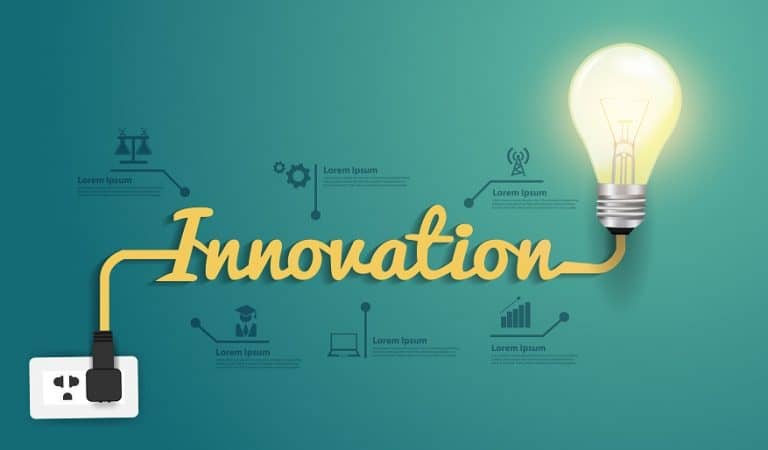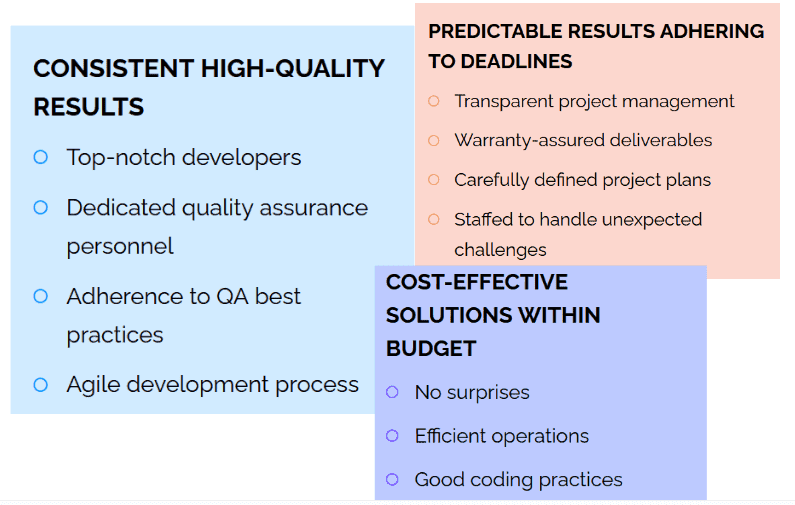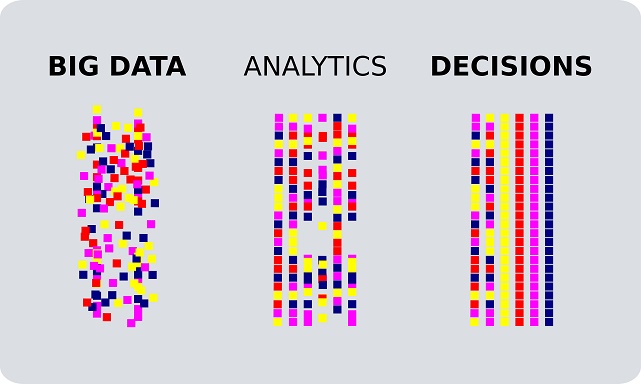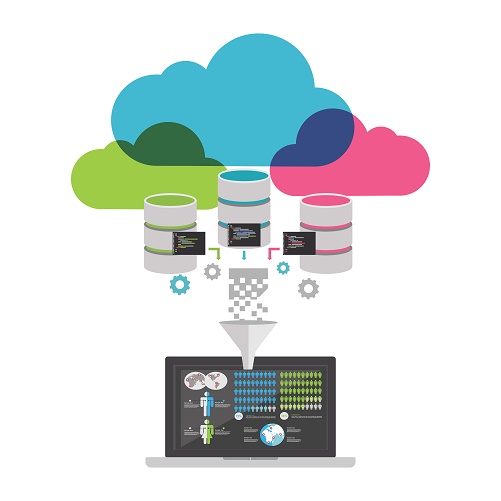Tag: predictive analytics
The automobile industry is one of the largest sectors in the world. In just the U.S., the car & automobile manufacturing industry boasts a market size of $104.1 billion.
However, even an ecosystem as large as the automotive industry is not immune to the unprecedented challenges over the last few years. The coronavirus pandemic and subsequent semiconductor chip shortage forced manufacturers to cut 11.3 million vehicles from production in 2021.
In addition to supply chain challenges, automotive manufacturers have contended with labor shortages, shifts in consumer demand, and pressures to create a sustainable work environment.
But, like any resilient industry, the automotive sector has leaned into these new challenges and has begun to address them proactively. Let’s take a closer look at what these hurdles entail and, more importantly, how automotive businesses overcome them via technology’s strategic implementation.
Challenges and Trends Reshaping the Automotive Industry
While many challenges and trends prompt the automotive industry to evolve, three stand out above the rest. These roadblocks include:
1. Ongoing Worker Shortages
Like many other business verticals, the automotive industry has been plagued by worker shortages. Manufacturers need help to fill vacancies at every level of the organization, including line-level staff, decision-makers, and engineers.
This worker shortage has made it nearly impossible to rebuild supply and catch up to runaway consumer demand for new vehicles.
2. Supply Chain Disruptions
Various legs of the automotive supply chain have faced disruptions over the last few years. Of these, the shortfall of semiconductor chips had the most significant impact on production and vehicle inventory.
Unfortunately, many experts predict the shortage will continue well into 2023, if not beyond. It is too late for automakers to prepare for this extended chip shortage. All they can do now is adjust manufacturing strategies to align with consumer demand and cut back production on less popular vehicles.
3. The EV Revolution
Despite these other concerns, the electric vehicle (EV) market continues to grow. By Q4 of 2022, EV sales represented 5.6% of all auto transactions. This percentage doubled from the year prior when EV sales made up just 2.7% of the total auto market.
This statistic demonstrates that consumers are becoming more environmentally conscious and are interested in decreasing their impact on natural resources. Government incentives and tax credits are further contributing to the surging popularity of electric vehicles.
But what does all this have to do with the future of work in the automotive industry? It means that automakers will need to implement new and more sophisticated production processes and hire better talent if they hope to push the envelope in the EV space.
The New Industry Focus: Creating a Sustainable Work Environment
One of the biggest drivers of change in the automotive industry is a global push toward creating a sustainable work environment.
Historically, the automotive sector has been anything but sustainable. Traditional assembly line-based production strategies focus on efficiency at the expense of almost anything else. These tactics result in the consumption of excessive amounts of power and often produce an unnecessary amount of resource waste.
However, the next-generation automotive industry will likely be unrecognizable to the pioneers of the last century. Modern manufacturers are reimagining every aspect of the supply chain, from material sourcing to assembly and distribution. Visionaries and thought leaders are also encouraging a shift away from old-school engineering and development processes in favor of AI-powered practices prioritizing efficiency.
Even the retail sales aspect of the automotive industry is changing. Many dealers are shifting toward online transactions, and some are transitioning increasingly to a made-to-order sales model. The end result is a more agile and less wasteful automotive supply chain.
Technologies that Can Fuel the Auto Sector’s Metamorphosis
The future of work in the automotive industry will focus on sustainability, resilience, and agility while prioritizing efficiency. To realize their aspirations of a sustainable work environment,
industry executives, managers, and workers must embrace leading-edge technologies, including:
1. Predictive Analytics Software
Predictive analytics software will influence numerous aspects of the automotive industry. Organizations interested in forging sustainable work environments can use these analytics tools to identify production waste and increase operational efficiency. Additionally, they can leverage these solutions to create more energy-efficient vehicles that produce fewer greenhouse gasses.
Predictive analytics technologies will also assist with demand forecasting — organizational leaders can use these insights to prioritize in-demand vehicles as they contend with ongoing chip shortages.
2. Automation Tools
Automation tools will prove invaluable amid labor and talent shortages. Businesses in the automotive industry can use automation software to streamline redundant back-office processes and improve communication across the entire supply chain.
Manufacturers can also use automation tools to ramp up production while conserving energy and reducing waste.
3. Machine Learning and AI Solutions
Machine learning and artificial intelligence technologies can transform every link in the automotive industry supply chain. Businesses can use these complementary technologies to optimize raw material sourcing, vehicle distribution, and production.
Because they allow for a more data-driven approach to manufacturing and sales, these technologies can reduce waste while simultaneously creating more agile and resilient supply chains. In turn, this will help keep the costs of vehicles manageable, thereby increasing accessibility to energy-efficient automobiles and EVs.
Read more: AI and ML for Faster and Accurate Project Cost Estimation
Accelerate Your Transformation with Fingent
When your business is in the automotive industry, creating a sustainable work environment should be one of your top priorities. Doing so will help you attract and retain top talent, meet consumer demand for more efficient vehicles, and align your business model with the latest regulations and compliance frameworks.
To achieve these goals, you will need access to purpose-built technologies designed for your business’s unique needs. That’s where Fingent top custom software development company, can help.
Our development experts can create dynamic software for your business. From customer-facing applications to internal solutions that empower your staff to be more productive, we build the software you need to thrive.
To learn more about our wide range of technology development services, connect with Fingent today.
Stay up to date on what's new

Featured Blogs
Stay up to date on
what's new



Talk To Our Experts
3 Reasons to Embrace Prescriptive Analytics in Healthcare
From flagging an unsafe drug interaction to activating a yearly reminder call for a mammogram, healthcare providers are leveraging patient data for a wide array of healthcare tasks. Yet, a worrying number of healthcare providers struggle to understand which one of the big data analytics methods, prescriptive or predictive, is most effective for their business.
Related Reading: 5 Ways Big Data is Changing the Healthcare Industry
Understanding the difference between prescriptive analytics and predictive analytics is the key to finding the right path to viable and productive solutions for your healthcare industry. This blog discusses why you should consider prescriptive analytics rather than predictive analytics to drive value to your business.
Predictive Analytics: The Ability to Forecast What Might Happen
Predictive analytics has been helpful to healthcare providers as they look for evidence-based methods to minimize unnecessary costs and avoid adverse events, which can be prevented. Predictive analytics aims to detect problems even before they occur using historical patterns and modeling. As the word itself suggests, it predicts. It gives you collated and analyzed data that could serve as raw material for informed decision making.
Related Reading: Data Mining and Predictive Analytics: Know The Difference
However, the healthcare industry demands a more robust infrastructure. It needs access to real-time data that allows quick decision-making both clinically and financially. It also requires medical devices that can provide information on the vitals of a patient up to the nanosecond. Based on the information available for the individual patient, clinical decision support systems should be able to provide an accurate diagnosis and the treatment options available. This must take into consideration the latest advances in medicine available as well. That is where prescriptive analytics comes into the picture.
Prescriptive Analytics: Reveals Actionable Next Steps
Prescriptive analytics takes it a step further by providing actionable next steps. If predictive analytics sheds light on the dark alley, prescriptive analytics reveals the stepping stones that would help map out the course of action to be taken. It empowers you to make more accurate predictions and gives you more options so you can make well-defined split-second decisions, which is critical for the healthcare industry.
According to Research and Markets, the global prescriptive and predictive analytics market is expected to reach $28.71 billion by 2026. The reason for such an increase is because prescriptive analytics has the capacity to analyze, sort and learn from data and build on such data more effectively than any human mind can. Hence, the most outstanding benefit of prescriptive analytics is the outcome of the analysis.
Three Reasons to Consider Prescriptive Analysis
MarketWatch states that Healthcare prescriptive analytics market is poised to grow significantly during the forecast period of 2016-2022. Here are 3 reasons why.
1. Sound Clinical Decision-Making Options
Unlike predictive analytics which stops at predicting an upcoming event, prescriptive analytics empowers healthcare providers with the capability to do something about it, helping them take the best action to mitigate or avoid a negative consequence.
To illustrate, a healthcare service provider might be experiencing an inordinately increased number of hospital-acquired infections. Prescriptive analytics wouldn’t just stop at flagging the anomaly and highlighting who would be the next possible patient with vulnerable vitals. It would also point to the nurse who is responsible for spreading that particular infection to all these patients. It could also prevent similar outbreaks in the future by helping healthcare providers develop a sound antibiotic stewardship program.
2. Sound Clinical Action
Prescriptive analytics doesn’t limit itself to interpreting the evidence. It also allows health care providers to consider recommended actions for each of those predicted outcomes. It carefully links clinical priorities and measurable events such as clinical protocols or cost-effectiveness to ensure that viable solutions are recommended.
To illustrate, a healthcare provider might be able to forecast a patient’s likely return to the hospital in the very next month using predictive analysis. On the other hand, prescriptive analytics would be able to drive decisions regarding the associated cost simulation, pending medication, real-time bed counts, and so on. Or, it could help you decide if you need to adjust order sets for in-home follow-up. It empowers the hospital staff to identify the patient with a greater risk of readmission and take needed action to mitigate such risks.
3. Sound Financial Decisions
Prescriptive analytics has the capability to lower the cost of healthcare from patient bills to the cost of running hospital departments. In other words, it helps in making sound financial and operational decisions, providing short-term and long-term solutions to administrative and financial challenges.
Gain the Benefits of Prescriptive Analysis
Prescriptive analytics provides enormous scope and depth as developers improve technologies in the future. It is making truly meaningful advances with regard to the quality and timeliness of patient care and is reducing clinical and financial risks. Are you ready to get on board? Contact us for help.
Stay up to date on what's new

Featured Blogs
Stay up to date on
what's new



Talk To Our Experts
Data Mining Vs Predictive Analytics: Learn The Difference & Benefits
With big data becoming the lifeblood of organizations and businesses, data mining and predictive analytics have gained wider recognition. Both are different ways of extracting useful information from the massive stores of data collected every day. Often thought to be synonyms, data mining and predictive analytics are two distinct analytics methodologies with their own unique benefits.
This blog examines the differences between data mining and predictive analytics.
Difference Between Data Mining and Predictive Analytics
Data mining and predictive analytics differ from each other in several aspects, as mentioned below:
Definition
Data mining is a technical process by which consistent patterns are identified, explored, sorted, and organized. It can be compared to organizing or arranging a large store in such a way that a sales executive can easily find a product in no time. Various reports state that by 2020 the world is poised to witness a data explosion. Therefore, data mining is a strategic practice that is necessary for successful businesses. It helps marketers create new opportunities with the potential for rich dividends for their businesses.
Predictive analytics is the process by which information is extracted from existing data sets for determining patterns and predicting the forthcoming trends or outcomes. It uses data, statistical algorithms, and machine learning techniques to identify the likelihood of future outcomes based on historical data. In other words, the aim of predictive analytics is to forecast what will happen based on what has happened.
Techniques and Tools
Although there are many techniques in vogue, data mining uses four major techniques to mine data. They are regression, association rule discovery, classification, and clustering. These techniques require the use of appropriate tools that have features like data cleansing, clustering, and filtering. Python and R are the two commonly used programming languages in data mining.
Unlike data analytics, which uses statistics, predictive analytics uses business knowledge to predict future business outcomes or market trends. Predictive analytics uses various software technologies such as Artificial Intelligence and Machine Learning to analyze the available data and forecast the outcomes.
Purpose
Data mining is used to provide two primary advantages: to give businesses the predictive power to estimate the unknown or future values and to provide businesses the descriptive power by finding interesting patterns in the data.
Predictive analytics are used to collect and predict future results and trends. Although it will not tell businesses what will happen in the future, it helps them get to know their individual consumers and understand the trends they follow. This, in turn, helps marketers take necessary, action at the right time, which in turn has a bearing on the future.
Related Reading: Predictive Analytics: The Key to Effective Marketing and Personalization
Functionality
Data mining can be broken down into three steps. Exploration, wherein the data is prepared by collecting and cleaning the data. Model Building or Pattern Identification by which the same dataset is applied to different models, thus enabling the businesses to make the best choice. Finally, Deployment is a step where the selected data model is applied to predict results.
Predictive analytics focuses on the online behavior of a customer. It uses various models for training. With the use of sample data, the model could be trained to analyze the latest dataset and gauge its behavior. That knowledge could be further used to predict the behavior of the customer.
Talent
Data mining is generally executed by engineers with a strong mathematical background, statisticians, and machine learning experts.
Predictive analytics is largely used by business analysts and other domain experts who are capable of analyzing and interpreting patterns that are discovered by the machines.
Outcome
Data mining enables marketers to understand the data. As a result, they are able to understand customer segments, purchase patterns, behavior analytics and so on.
Predictive analytics helps a business to determine and predict their customers’ next move. It also helps in predicting customer churn rate and the stock required of a certain product. Additionally, predictive analytics enable marketers to offer hyper-personalized deals by estimating how many new subscriptions they would gain as a result of a certain discount, or what kind of products do their customers seek as a complement to the main product they bought from the seller.
Related Reading: Using Predictive Analytics For Individualization in Retail
Effect of Data Mining and Predictive Analytics on the Future
The global predictive analytics market is estimated to reach 10.95 billion by 2022. We are now in a period of constant growth, where businesses have already started using data mining and predictive analytics sift through the available data for searching patterns, making predictions and implementing decisions that will impact their business.
Both approaches enable marketers to make informed decisions by increasing productivity, reducing costs, saving resources, detecting frauds, and yielding faster results. To make the best use of data mining and predictive analytics, you need the right guidance and the best expertise. Talk to our experts and find out how Fingent can help your business scale up with the power of data. Get on your way to a digital-first future with Fingent.
Stay up to date on what's new

Featured Blogs
Stay up to date on
what's new



Talk To Our Experts
The relentless advancement of technology force a churn in many industries and the real estate sector is no different. As it is with most positive disruptions, technology facilitates doing things faster, cheaper, and more efficiently.
Online Services Make Processes Easy and Efficient
Many businesses have shifted entirely online, and other businesses facilitate online mode in a big way. Hitherto, the online component of real estate services has been mainly limited to property searches. However, things are changing, both in depth and scope.

Easy and seamless solutions are now available to conduct the entire process, right from property search to signing agreements online. Virtual Reality and Augmented Reality technology enable making virtual site visits, with annotations that offer even greater insights than an actual site visit would deliver. Collaborative suites make negotiations between agents, property owners and tenants easy, and methodical. Integrated payment options allow the tenant to make deposits and rents seamlessly, without the hassles of follow-ups and manual accounting. Many realtors already have their agreements online, with digital signatures.
For the realtor’s end, online technology makes things easier, convenient and more accurate. Big data analytics and the infusion of artificial intelligence allow realtors to score leads more accurately, predict what their customers want in a highly specific manner, and engage with them in a more customized way.
Field service apps enable field agents to connect with the head office, clients, and other stakeholders easily, on a 24×7 basis, addressing needs proactively, and solving issues in the bud.
An integrated platform, with a cloud-based backend and intuitive mobile apps for different stakeholders in the front end, and co-opting the latest technology such as Virtual Reality, is all set to become the technological backbone of an efficient and well run real estate enterprises in the near future, and is a priority for realtors seeking to take their business forward in an increasingly tech-centric world. Providers such as Zillow has already made a start, aggregating real estate data down to details on each available property, allowing consumers to learn everything about an interesting property, with just a few clicks or swipes.
Case Study: Self Showing App – an IoT application developed for Realtor
Greater Insights Lead to Stability and Predictability
The real estate industry is turbulent in nature, with cycles of oversupply and depressed prices, followed by high demand and prices going through the roof. Macroeconomic conditions such as recession can lead to a crash, followed by rebounds. The problem with such a scenario is nobody can predict the market.


However, things are changing, thanks to technology. Big data analytics, in combination with predictive analytics, can crunch data from a variety of sources and predict the future to a fair level of accuracy. If nothing else it may be able to predict future demand, enabling realtors to predict demand and supply accordingly, and thereby keep prices stable. Such insights would also enable governments and regulators to intervene in the real estate markets in a more proactive and meaningful way, protecting the interests of all stakeholders.
Advanced algorithms can even match home buyers or sellers with the most suitable agents, eliminating the wastage and inefficiencies associated with the present models, and sparing the need for relying on hunches or trial and error methods.
Also, real estate prices are now by and largely subjective. Big data analytics and an accurate insight into the demand-supply situation would enable price fixation in a more objective and scientific manner, benefiting everybody. For the realtor, it reduces the speculation and risk, leading to more stable and predictable ROIs.
For the success of back-end operations, big data analytics, infused with artificial intelligence and predictive analytics is just as important for a realtor.
Technology Propels Innovative Business Models
Technology has enabled rolling out a host of innovative business models, not possible before.

- Advanced big data analytics predict property prices to a great level of accuracy, taking away uncertainty and agents who over quote or under quote, infusing a much-needed transparency into the process, and reducing the hassles of price fixation – one of the biggest banes of the industry.
- Uber-like rental platforms, with pre-approved rating scores, background checks, standard agreement forms, and other normally time-consuming hassles, make rental just as easy as availing a taxi. Technologies such as online reservation systems and e-conveyance make property buying easy and hassle-free as well.
- Innovative cloud based models facilitate auctions or allow lessors or buyers to bid for the property. New apps that facilitate live stream without any time lag eliminate the need for physical auctions or meetings.
These models enable realtors to find new customers and close deals faster, increasing their ROI manifold. Most of these models are becoming very popular and are all set to become the benchmarks in the near future.
Property investment becomes Democratic
Technology is enabling a significant shift with regards to the investment model of real estate. Hitherto, the reality is the exclusive domain of high net worth investors, with small and medium investors priced out of the market due to the high ticket size of real estate investment and the cumbersome, time-consuming effort involved in the process.

New, online-centric ownership model allows even small investors to become part investors, or invest “bricks” in an edifice. Such investors earn ‘dividends’ in the form of rental returns and can trade their bricks like a traditional stock market. Naturally, a strong and robust online platform which facilitates a smooth and transparent buying and selling process, and takes care of all regulatory, legal and other formalities is the key to success of this model. It is a win-win situation, as a lesser entry ticket means more buyers flooding the market, enabling more sales, accelerating the sales cycle, and increasing the ROI.
The other end of such democratization is crowdfunding real estate projects. Crowdfunding now makes up less than 1% of total real estate investment volume, but such investments are all set to take a quantum leap.
Needless to say, this is all poised to become of the biggest disruptors of the realty market in the coming days, as the new models mature and gain a foothold.
Creating electronic solutions has its own set of challenges, and disruption of the existing business models would be met with resistance by those who benefit from the status-quo. However, such resistance would be like battling with the waves. As the saying goes “No army can stop an idea whose time has come.”
For all the possibilities enabled by technology, success depends on rolling out well-designed, robust systems. Real estate players need to tie up with a strong technical partner who has the expertise and know-how to deliver intuitive mobility and other solutions that leverage the latest technological capabilities to realize the desired business models and take customer satisfaction to a new level.
Stay up to date on what's new

Featured Blogs
Stay up to date on
what's new



Talk To Our Experts
Big data has come a long way in 2016, but there is scope for much more. Here are the top big data trends, or how enterprises would leverage big data in new and innovative ways, going forward.
1. Dominance of the Cloud
The spread of the cloud notwithstanding, many small and medium enterprises still rely on on-premises data centers. As such legacy data centers reach their end of life, and as the benefits of the cloud become too tempting to ignore, there will be an increased migration to the cloud.
The future of big data for the enterprise is in the cloud, considering the infinite power and flexibility on offer. The cloud enables enterprises to tap into the required resources with a few mouse clicks, without having to take the trouble for provisioning, or seek talent to run in-house Hadoop clusters and processing. The migration to the cloud also cut costs in maintenance and operations.
2. Incorporation of Live IoT Data
The Internet of Things is in the throes of effecting a paradigm shift in all things computing. If anything, it will enrich Big Data analytics with even more data. With IoT gaining center stage, the focus of Big Data for the enterprise will shift to processing real-time and actionable data derived from IoT sensors and other live information, and transmitting the same to users and machines, for actionable information.
Enterprises will be faced with the increasing need to integrate and make sense of data entered by humans and data captured by machines, to aggregate composite visualizations. For instance, data from drones, combined with sensory and standard IT inputs, merged into a single pane of glass view would offer fresh multi-dimensional insights not possible before.
3. The Use of More Dark Data
The spread of computing and the Big Data trend of digitalization has been underway for some time now, but much of enterprise data are still trapped in paper-based documents, paper photos, CD’s, vaults, storage closets, and unconnected hard drives. Such data may be invaluable in offering historical insights and performance trends. Among the key Big Data trends would be demolishing silos that lock up data in the first place, and integrate such trapped data, to ensure comprehensive and complete analysis.
For the enterprise, accessibility and relevance of historic data become even more relevant in today’s hyper-competitive and a cut-throat world, where trademark infringement and/or intellectual property violation claims are manifold.
4. Focus on the Results rather than the Efforts
The proliferation of data makes it important to separate the wheat from the chaff. The terabytes of data being generated from multiple sources can drown even the most efficient of enterprises. To cope with the challenge of crunching terabytes of data, more and more organizations are now adopting Hadoop and other big data stores.
With the focus on results than effort, executives seek out relevant insights. Side by side with a focus on real-time analytics and insights, Big Data analytics will increasingly focus on data and results that really matter and add value to the bottom line, rather than analytics for the sake of it. Big Data vendors are introducing new and innovative Hadoop-based advanced analytic solutions towards this end, and enterprises have no option but to embrace such tools.
5. Immediately Gratifying Analytics
Today’s fast paced world demand instant results, fuelling the demand for real-time analytics capabilities. Today’s business executives demand real-time actionable data, in easy to consume and attractive graphics. The delivery of graphics is likely to become more flexible and innovative and take newer dimensions, such as 3D visualizations, as well.
Enterprises who do not cater to such pressing need face the risk of being left out, as competition becomes increasingly sophisticated and use innovative tools to gain better insights, to convince customers.
6. The Rise of Predictive Analytics
Today’s enterprises are going one step ahead of real time analytics and delving into predictive analysis, to take decisions that contribute to the bottom line.
Big Data providers now offer solutions that crunch historic data to predict events and behaviors, allowing marketers and enterprises to position them to make the kill. Predictive analytics also help in fraud detection and minimize risk exposure, besides, make operations more efficient than ever before.
7. The Rise of Self-Service
In tune with the efficiency-oriented lean philosophy, self-service is setting in even in big data preparation and analytics.
Self-service data preparation tools boost time to value, allowing enterprises unmatched flexibility and also making it easier to include unstructured and semi-structured data in the analytics. It also improves trust and reliability in the data included for analytics, considering end users who deal with the data would know its relevance, for inclusion in analytics. The decreased reliance on technical experts empower end users to no small extent and improve operational efficiency in the process.
Self-service in data analytics plays into the pressing need for customization, further boosting efficiency.
8. Increasing Reliance on Data Virtualization
Today’s data is not just voluminous, but also complex, and unstructured. Big data solutions are increasingly relying on data virtualization to unlock what is hidden within large data sets. Graphic data virtualization especially enable enterprises to retrieve and manipulate data on the fly, regardless of how the data is formatted or where it is located.
Through such virtualization techniques, the enterprise may optimize their business intelligence, and unlock better insights.
9. Stronger Administration of Data Security Permissions
With the trend of moving all data into a single integrated data warehouse and repositories, all users would access the same data, but on a “need basis.” The coming days is likely to see more attention to fortifying access permissions and data security. Creating and or revising data access permissions policies, and implementing technology to monitor and detect potential data exfiltration by users is likely to take center stage in the coming days.
10. Increasing Thrust on Security
Security has always been a pressing issue.The convergence of various big management elements such as data quality, data preparation, and data integration, necessary for big data analytics, the increasing reliance on smart devices for generating data, and the increasing regulations in the wake of high-profile breaches raises the stakes of security higher than ever before.
The ramifications of Big Data breaches will be huge, with potential for serious reputational damage and crippling legal repercussions.
With big data being increasingly used for mission critical applications, the stakes have never been higher. As Big Data is expected to go leap and bounds, it is important for enterprises to stay abreast of the latest developments, to remain on the top of the game. Partnering with us for your Big Data plans offers a safe bet, considering our vast experience and expertise in the field, and our track record of having successful implemented several cutting-edge projects, cutting across industries.
Stay up to date on what's new

Featured Blogs
Stay up to date on
what's new



Talk To Our Experts
Gone are the days when marketing in retail, meant hours of trial-and-error based planning and strategizing. Marketing is no longer reliant on the marketer’s gut feelings or intuitions. It is moving away from being an art and is becoming more of a science now.
One of the major reasons that can be attributed to this shift is big data. Yes, the endless amounts of data that are being collected by businesses on an on-going basis are changing the game for retail nowadays. Business enterprises that leverage this data through analytics, and uncover useful insights are able to make their marketing plans more effective.
Isn’t it great when you are able to analyze what kind of products your customers are likely to buy, or what is the highest price that a customer of yours is willing to pay for a particular product? You get to channel your marketing efforts in the direction which is most likely to give you better profits with such information.
With predictive analytics, you get to garner all the insights necessary to personalize your marketing efforts for customers, making it much more effective and useful.
So here are some of the areas where you can use predictive analytics for personalization:
Customer engagement and revenue
 Predictive analysis helps to identify the different ways in which customers engage with retail sites. This information can be used to drive the desired level of engagement from the customers.
Predictive analysis helps to identify the different ways in which customers engage with retail sites. This information can be used to drive the desired level of engagement from the customers.
There are several solutions available in the market that can help you figure out or track customer behaviour. You can use those solutions to get a better understanding of what your customers are like, and have them adapt to your business model as your objectives evolve.
For example, retail giants like Amazon and Netflix, use predictive analysis to examine customer behaviour and develop solutions for their sales team to earn better and more qualified leads.
Amazon makes use of customer’s past purchases, details about their virtual shopping cart items, the items they have liked or rated etc. to decide and offer future product recommendations.
Netflix makes use of ratings made by customers on TV shows and movies to offer additional movie and show recommendations.
This way, predictive analysis tools help a great deal in obtaining information which when combined with a company’s already existing customer base, enables better and more effective marketing.
Better focused promotions
 Promotions are every retail company’s best friends. But to get them right and to get leads out of them, you need to make some serious effort.
Promotions are every retail company’s best friends. But to get them right and to get leads out of them, you need to make some serious effort.
Studies say that almost 98% of fast growing companies feel that targeting and market segmentation are extremely important for online merchandising but more than half of them are not completely satisfied with their promotional tools.
Predictive analysis can be used to avoid such situations and devise personalized promotional strategies that work for a particular customer or a particular segment, by combining data collected from various sources.
For example, Macy’s used a predictive analytics solution that focused on targeting registered users of their website and within three months, they saw an 8 to 12% increase in online sales. They used information related to browsing behavior and combined it with product categories to send out targeted emails to each customer or market segment.
Similarly, another retailer StitchFix sends out a style survey to customers, on the basis of which the customers are given recommendations on the clothes they might like, using predictive analysis.
Inventory management
Predictive analytics can be used in inventory management as well in order to prevent out of stock situations and to reduce overstock.
One retailer that revolutionized inventory management by introducing a system of Vendor Managed Inventory (VMI), was WalMart. They made use of predictive analytics to take it to an all new level, whereby they could reduce the inventory threshold for a product if the solution predicts no immediate sales for it. This allowed them to allocate their resources on products that are greater in demand and have the potential to increase profits.
Customer service
Many retailers face issues in customer service relating to whether or not they need phone service, if yes the number of executives required for phone-based support, live chat services, prioritizing questions from customers and the like.
Predictive analysis helps to set this line straight, by building a model that specifically meets the needs of the retailer. Over time, the model or the solution can be refined and modified for more accurate predictions and improve overall customer service.
For example, Red Hat which is a Linux distributor uses predictive analysis to enhance customer service by increasing “subscriber stickiness”. With their solution, they were able to provide solutions to customers, for problems they didn’t even know they had.
Hotel chains like Marriott also use predictive analytics tools with the aim of exceeding their customer expectations at all times.
Apart from these, there are many more areas where you can use predictive analysis.
However, merely using a predictive analytics solution and dumping data in is not enough. They are not plug and play solutions, that take data in and generate revenues. You need to work with skilled data analytics personnel to make sure that your investments in predictive analytics are not wasted. You need analytics experts to make the most out of big data. Once you have the right solution as well as the right personnel in place, then you are not far away from effective marketing.
Stay up to date on what's new

Featured Blogs
Stay up to date on
what's new



















